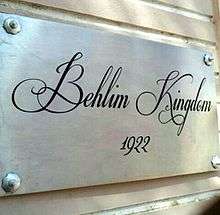Behlim
| Total population | |
|---|---|
| (68400) | |
| Regions with significant populations | |
| • India • Pakistan • Bangladesh | |
| Languages | |
| • Urdu • Hindi • Gujarati • Punjabi | |
| Religion | |
|
• | |
| Related ethnic groups | |
| • Shaikh • Shaikh of Uttar Pradesh • Shaikh of Gujarat • Nagar Muslims |
The Behlim(Belim) are a Muslim Rajput community found mainly in North India. A large number are also found in the cities of Karachi and Multan in Pakistan.[1]
Origin
Behlim (Belim) is sub-caste of Rajput. Behlol Lodhi is also Rajput and he started this sub-cast with his name in 1486. The Behlim (Belim) trace their descent the Sufi Masud Ghazi, and the word is said to be a corruption of the word ba-ilm, meaning those who are knowledgeable in Arabic. There are in fact two distinct communities of Behlim (Belim), those of Gujarat, who are found mainly in [Mansa-ITADRA] Mehsana and Banaskantha districts, while those of Uttar Pradesh, who are found mainly in the Doab region of that state.[1]
In Pakistan
In Multan/Bahawalpur
The Behlim (Belim) families are present all over Pakistan, especially in Multan. Behlim (Belim) is sub-caste of Rajput. Behlol Lodhi is also Rajput and he started this sub-caste with his name in 1486. There are many welfare societies with Rajput name but Punjabi Rajput Welfare Society is well known society in Multan. Behlim (Belim) family played front line role in the foundation of this society. These families migrated from India during the partition.
In Daharki/Sindh
Behlim (Belim) families are also living in Daharki in Ghotki District of Sindh, which is a starting city of Sindh from Punjab towards Karachi. These families were migrated from Northern India (Sirohi, Rajasthan) during the partition.
Other locations
Behlim (Belim) families also live in Vehari, Sahiwal (Maisi Tehsil Verhari and in central area of Sahiwal), Pakpatan, Khanewal, Kabirwala, Jhang/Faisalabad (Shorkot, Khurarianwala), Rahimyar Khan, Sadiqabad, Fatehpur-Shekhawati(Sikar-Rajasthan) and Khanpur.
Present circumstances
In Gujarat
The Behlim (Belim) are an agrarian community, found mostly in north Gujarat. According to some traditions, they were once Rajputs, and their customs are similar to other Muslim Rajput communities, such as the Maliks. The Behlim (Belim) intermarry with other Gujarati Muslim communities of similar status such as Pathan, Shaikh and Molesalam Rajputs. Unlike other Gujarati Muslims, they have no caste association, and generally are allied to other Rajput landholding classes. They speak Gujarati and are Sunni Muslims.[1]
In Uttar Pradesh
In Uttar Pradesh, the Behlim (Belim) are found mainly in the Doab region of western Uttar Pradesh. They claim to be of Turk origin, having arrived in India during the time Iltutmish. The Behlim (Belim) families of the city of Bulandshahr played an important role in the history of that city. Other Behlim (Belim) are found mainly in the neighbouring districts of Meerut and Muzaffarnagar. In addition to the Behlim (Belim) of the Doab, there are two other settlements in Gonda District and Basti District in eastern Uttar Pradesh. These Behlim (Belim) have little or no connection with those of western Uttar Pradesh. Both the Behlim (Belim) communities speak Urdu, and as a largely urban community very rarely speak any of the local dialects of Hindi. They are largely Sunni, although there is a small Shia minority. The community considers itself as belonging to the wider Shaikh community of South Asia.[2]
In Rajasthan

The main population of Behlim in Rajasthan is found in Sikar, Fatehpur Shekhawati, Sujangarh, Nagour, and other small cities.The Behlim Kingdom [Haveli] is situated in Fatehpur Shekhawati, built in the year 1922 by the legendary Haji Deen Mohammad Behlim, one of the prominent figures of the region.